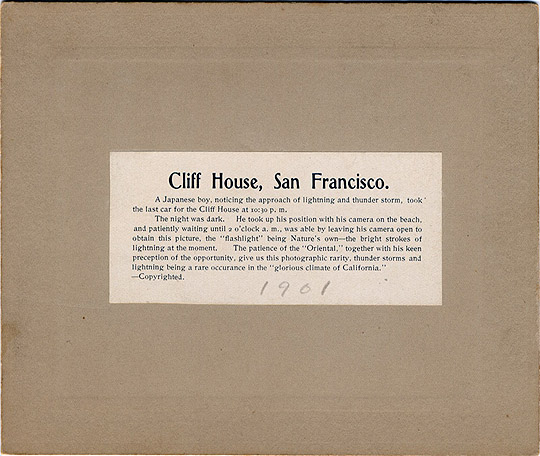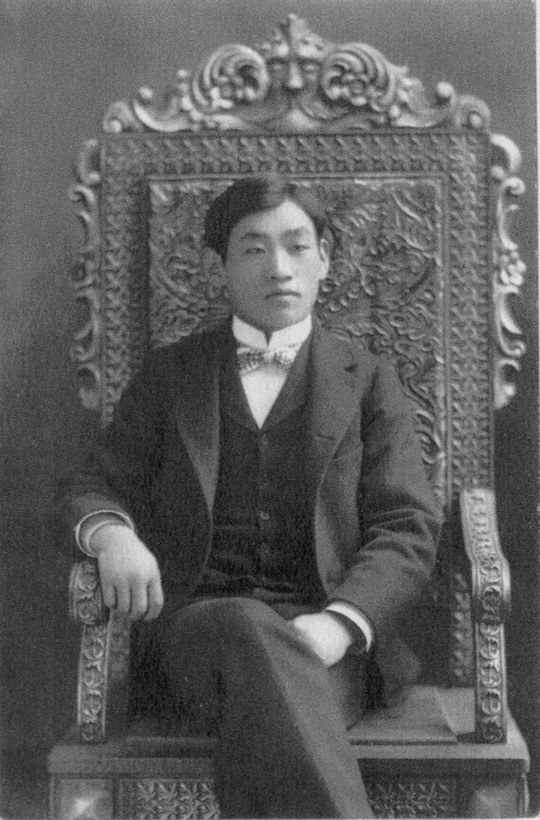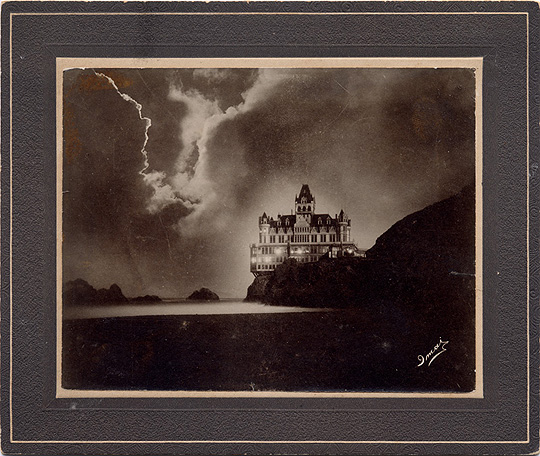It’s one of the most famous San Francisco images, seen on postcards galore. I never realized what an epic story is attached to it and the photographer who is believed to have shot it. (Also, it’s not lightning, nor a storm, as is commonly held.)
According to this Cliff House book project site, on the back of the original print is the following inscription (neither dated nor verified):
A Japanese boy, noticing the approach of lightning and thunder storm, took the last car for the Cliff House at 10:30 p.m.
The night was dark. He took up his position with his camera on the beach, and patiently waiting until 2 o’clock a.m., was able by leaving his camera open to obtain this picture, the “flashlight” being Nature’s own–the bright strokes of lightning at the moment. The patience of the “Oriental,” together with his keen preception of the opportunity, give us this photographic rarity, thunder storms and lightning being a rare occurance in the “glorious climate of California.” –Copyrighted.

There’s more. The “Alamo Square Neighborhood Association Newsletter” from February 2000 identifies (via his son, “Ted”) the Japanese boy as Tsunekichi Imai.

Scan courtesy of Winston Montgomery
The following story is included in a detailed account of Imai’s life:
Tsunekichi Imai was working in his Polk Street studio when the 1906 earthquake struck, and he described to his family how the pictures hanging from his shop walls shook and gyrated wildly, many tumbling to the ground. In the days that followed, the rapidly spreading fire which followed the quake overwhelmed firefighters and threatened to destroy the entire city. To stop the fire by depriving it of fuel, officials decided to create a firebreak by dynamiting a swath of buildings east of Van Ness Avenue. The Imai studio was located in one of these buildings.
The structures to be exploded were evacuated hurriedly and Tsunekichi Imai thought that all his equipment and furniture had been lost. Someone suggested that he go up to Lafayette Park at Washington and Laguna streets, and there he discovered stacks of personal possessions and household furnishings covered by tarpaulins that firemen and other volunteers must have rescued from the doomed buildings. He found most of the things from his shop piled together and even labeled with his name. Ironically many of the photographs and other personal affects that survived the earthquake and fire were lost during the period that the Imai family was interned during W.W. II at Camp Topaz in Utah.
Tsunekichi Imai took a number of photographs in the earthquake’s aftermath, the most notable, according to his son, Ted, showed a man trapped on the upper balcony of a burning building pleading for help as the flames engulfed him. The picture was taken just as soldiers on the ground shot the man with their rifles to put him out of his misery. Ted says his father was fearful of the possible legal implications of taking this photo or even witnessing this event, and eventually destroyed it.
Read the whole thing.
Tons more photos of Cliff House here.

You mention it’s neither a storm, nor lightning. That’s not made clear in the caption or text about the purported photographer. What am I missing?
it’s mentioned in the extended text on the source site. also mentioned here: http://commons.wikimedia.org/wiki/File:CliffHouseStorm.jpg
Is there any published explanation for the subliminal image of a head (side view) above the CH in the top right?
Imaginos!
http://tinyurl.com/2wft2fr
I have a real story on this, I worked for Moulin Studios for 5 years, as a photographer and dark room printer. btw, SF’s oldest Studio since 1886. Tom Moulin told me this was printed by shooting clouds with the sun, then montaging the two images in the darkroom, with the clouds as a double exposure and the Cliff House, and turning the easel so that the clouds would appear this way, in fact the clouds were actually upside down in this picture for dramatic effect. Then once the master was printed it was re-photographed with an 8 x 10 Camera, and made into an 8 x 10 Negative and then contact printed for the remaining 100’s that were produced.